All about mulching: the perfect way to nourish your lawn
Many of us with gardens dream of a healthy, green lawn. But the question often comes up of how best to look after the grass and keep it healthy. One tried and tested method that has become more and more popular in the last few years is mulching. With mulching, the grass cut by the mower is not collected, but left on the lawn as mulch, returning nutrients to the soil as a means of natural fertilisation. So, what are the benefits and drawbacks of this method? Which equipment works best for mulching? How often and when should you mow and mulch? In this blog post, we will answer all of these questions and share some valuable mulch mowing tips.

Definition: What is "mulching"?
When we talk about "lawn mulching", we basically mean spreading grass cuttings directly onto the mowed lawn. To do this, it is important that the grass is not just cut, but shredded even finer, before it ends up on the ground as a natural fertiliser.
The shredded grass forms a "mulch", i.e. a loose top layer of soil. Because the green cuttings are made of organic material, this process feeds natural nourishment back into the soil. If you want to maintain your garden sustainably and ecologically, and prefer to avoid industrially manufactured fertilisers, mulching is the perfect way for you to care for your lawn and ensure a healthy, expanse of green.
A sustainable fertiliser: How does mulching work?
In general, mulch refers to a layer of organic material which is applied to the soil. Depending on the type and purpose of the mulch, different materials can be used. These include shredded grass, leaves, chopped branches, twigs and waste wood, straw or stones. One of the most well-known is bark mulch, which is made from chopped tree bark. The mulch layer serves to protect the soil below. The layer of mulch regulates the temperature when the weather is very cold or hot and protects the lawn from strong sunlight, and also prevents moisture loss and drying out. This helps the plants grow healthier and thicker, preventing weed growth and giving your turf a fuller appearance.
For mulching a lawn, finely chopped grass clippings are the best choice. These don't just form a protective layer for the soil, but also puts back important nutrients such as nitrogen, phosphorous and potassium. To improve the take-up of this feed, you can also work the grass trimmings into the earth using a rake. Because the grass clippings are reused as fertiliser, from an ecological point of view this completes the natural cycle, all the while making your lawn more resilient, healthy and green.

How often and when should you mulch?
Consistency is everything when it comes to fertilizing or mulching your lawn. Ideally, you should mow and mulch your lawn roughly every 7 to 8 days. It is important when doing so to ensure that the grass has not grown too tall, as spreading too much mulch on the soil can deprive it of air to breathe and suffocate it. If too much of the grass is cut at once, in most cases it cannot be chopped as finely. Bear in mind that the finer the cuttings, the better the soil can absorb the nutrients.
As a rule, the grass should be mulched regularly throughout the whole gardening season, in other words, from spring through to autumn, as long as it is also mown regularly. If you follow these guidelines, you can ensure your garden receives the best possible care and achieves a healthy, green appearance.
Comparison: Mulching vs. mowing
In the world of lawncare, one question that is sure to divide opinion: Should you mow and mulch separately, or at the same time (i.e. mulch-mowing)? Both approaches have their benefits and drawbacks, and it is important to understand the differences so you can choose the best method for your lawn.
Different ways of working
- Mowing: With a typical mower, you trim your lawn, and collect the grass clippings in the grass collector. Afterwards, you can either dispose of the grass clippings, or put them to compost.
- Mulching: Mulching involves shredding cuttings such as grass, leaves, branches and so on and spreading them as a layer on top of the soil. To do this, you would either use a mulch-mower or a shredder.
- Mulch-mowing: Mulch-mowing combines three steps into one, since as you are mowing your lawn, the green cuttings are chopped inside the mulch-mower and then not fed into the grass collector, but instead ejected directly onto the lawn. In actual fact, you are doing four jobs at once: mowing, shredding, mulching and fertilising.

The right equipment for mulch-mowing
Not every lawnmower is suitable for mulch-mowing. To chop the cut grass even finer inside the lawnmower, it needs to have a mulching function. This serves two purposes: firstly, it ensures that the grass is "shredded" into small pieces, and secondly, it spreads the cuttings directly onto the lawn. This also means that you can mow without attaching a grass collector. For example, in addition to our specialised models of mower, all of our robot lawn mowers are also mulch-mowers.
Here are some garden tools you can use for mulch-mowing:
- Lawnmower with mulching kit: Certain models, such as the cordless lawnmowers RASARRO 36/38 and GE-CM 36/43 Li M, and even our petrol lawnmower GC-PM 51/3 S HW, come with a mulching plug or mulching adapter. When this is installed in the lawn mower, it ensures that the clippings remain in the mower body longer and are chopped finer. By installing the mulching adapter and putting the grass collector to one side, the lawn mower can be converted into a mulch-mower at any time.
- Cordless mulch-mower: The cordless lawn mower GE-CM 36/48 Li M does not come with a grass catcher. It is a pure mulch-mower with a robust sheet-steel chassis.
- Robot lawnmower: All Einhell robot lawnmowers can be considered mulch-mowers because they leave the grass clippings on the lawn. For optimal mulching, the mower should run regularly, e.g. every day. This way, it only trims off short pieces of the blades of grass, which means they do not need additional shredding, and are perfect for mulch.
Benefits and drawbacks
To help you decide whether you prefer to mow your lawn normally or mulch it regularly, we have summarised the advantages and disadvantages of each method.
Lawn mulching / Mulch-mowing
Advantages
- Natural fertilization: The soil is optimally re-supplied with exactly the nutrients it needs, coming from the clippings produced when mowing the lawn. This helps the grass grow healthier and greener.
- Protective layer: The mulch layer reduces the effect of changes in temperature and traps moisture, so the lawn won't dry out as quickly.
- Economical: You won't need to buy extra lawn feed, which saves you money.
- Reduces waste: You avoid having to dispose of the grass cuttings by recycling them directly in your own garden.
Disadvantages
- Consistency: The lawn must be mulched and mown regularly, to avoid too much mulch accumulating at once, and allowing time for the mown grass to be broken down.
- Risk of lawn thatch: If the grass is too tall when it is mown and used as mulch, lawn thatch can form. However, this can be removed again by scarifying.
- Soil suitability: Mulching is not suitable for all soils, e.g. sandy and loamy soils, or areas in a lot of shade.
Lawn mowing:
Advantages
- Flexibility: When just mowing the lawn, you don't have to follow exact intervals. The cutting height can be adjusted depending on the length of the grass, so you can even mow just once a fortnight.
- Visual appearance: The lawn looks tidier, because the grass clippings are neatly collected in the grass collector.
- Compost: The cut grass is perfect for composting.
Disadvantages
- Extra maintenance: Conventionally mown areas usually require extra lawn feed. This has to be purchased, and then applied separately, unlike in mulch-mowing, which ticks off both jobs in one go.
- Lack of protection: The lawn is exposed to the sun and weather without protection, and dries out faster in the heat and sunlight.
How-to and tips: What you need to look out for when mulch-mowing
Using lawn clippings as mulch just makes sense. By the way, if you collect the cut grass from a traditional mowing in the grass collector, you don't have to throw it in the organic waste afterwards; instead, you can tip the garden waste on your compost heap, so that it will decompose into valuable fertilizer for the next gardening season. We explained in another blog post which other garden waste can be composted and some useful ways you can recycle it.
If you opt for regular mulching, there are a couple of things you should keep an eye out for.

The optimal cutting height of your lawn
If you spread too much mulch, or the grass clippings are chopped too coarsely, the mulch layer may "suffocate" the soil below. The cuttings deprive the blades of grass of light and air to breathe. This increases the risk that your lawn will dry out and develop brown patches or even form lawn thatch. For a lush, green and well looked after lawn, you should therefore make sure not to cut too much off the grass, and to shred the clippings very finely, either by using the mulching function of your lawn mower, or the frequent mowing schedule of your robot lawn mower.
The amount you should take off always depends on the weather and the grass itself.
- Recommended mowing time: when the grass is 6 - 7 cm tall
- Recommended cutting height: trim to 4 - 5 cm
- Exception for shaded lawns: at 8 cm tall, cut to max. 5 cm
By shaded lawns, we mean those lawns which receive little or no sunlight. Without the UV rays (and because of the lower temperatures) the grass grows more slowly and should therefore not be cut as short. By the way, in temperatures below 12 °C or above 28 °C, grass usually grows slower, if at all. Also, the more it rains, the faster the grass grows.

EXTRA TIP
If you mulch your lawn very frequently, you can give it a "refreshing treatment" in autumn and spring by scarifying it. This removes old cuttings from the lawn so that it can breathe better and absorb new nutrients. Want to learn more about this? Then you will find this blog post interesting.
Keep an eye on the weather: never mulch wet grass!
If at all possible, you should avoid mowing the lawn when it is wet, and you should not use it as mulch. The wet grass clippings stick to the mower housing and form clumps. When these are spread onto the lawn, they will dry more slowly, which can lead to rotting and decay.
When is mulching not recommended?
Although in most gardens mulch-mowing is easily possible, and indeed very useful, there are a few cases where it is not recommended.
- Heavy soils with low permeability: Loamy, poorly aerated soils do not absorb nutrients very well.
- Sandy soils: There is very little biological activity in sandy soils, which means that the nutrients are not digested properly.
- Shaded lawns, areas of high rainfall: Mulch decomposes particularly well in sunny conditions. Places with a lot of rainfall can also cause issues with the mulch, because if it gets too wet it will start to rot and encourage moss growth and the formation of lawn thatch.




